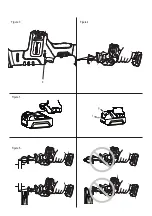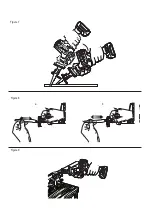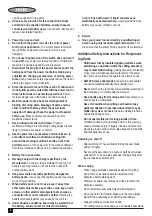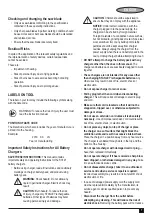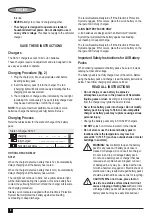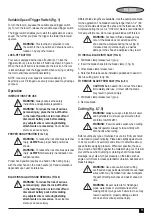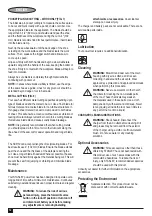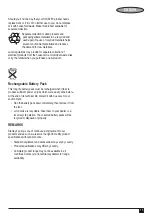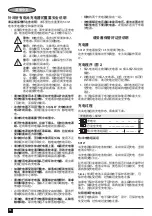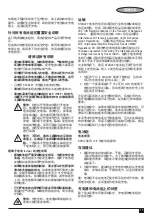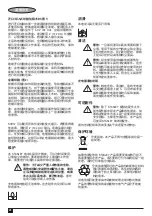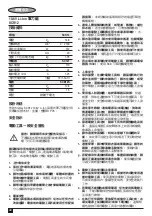
11
ENGISH
Variable Speed Trigger Switch (fig. 1)
To turn the tool on, squeeze the variable speed trigger switch
(a). To turn the tool off, release the variable speed trigger switch.
The trigger switch enables you to start the application at a slow
speed. The further you press the trigger, the faster the tool will
operate.
WARNING: This tool has no provision to lock
the switch in the on position and should never be
locked on by any other means.
LOCK-OFF BUTTON
Your saw is equipped with a lock-off button (b). To lock the
trigger switch (a), press the lock-off button as shown in figure 3.
When the lock-off button is depressed to the lock icon, the tool
is locked. Always lock the trigger switch when carrying or storing
the tool to eliminate unintentional starting.
NOTE: Use of very slow speed is recommended only for
beginning a cut. Prolonged use at very slow speed may damage
your saw.
Operation
INSTRUCTIONS FOR USE
WARNING: Always observe the safety
instructions and applicable regulations.
WARNING: To reduce the risk of serious
personal injury, place the lock-off button
in the lockoff position or turn tool off and
disconnect battery pack before making
any adjustments or removing/installing
attachments or accessories. An accidental
start-up can cause injury.
PROPER HAND POSITION (FIG. 1, 4)
WARNING: To reduce the risk of serious personal
injury, ALWAYS use proper hand position as
shown.
WARNING: To reduce the risk of serious personal
injury, ALWAYS hold securely in anticipation of a
sudden reaction.
Proper hand position requires one hand on the hand grip (e),
with the other hand on the main handle (d). Hand orientation is
dependent upon user’s preference.
BLADE INSTALLATION AND REMOVAL (FIG. 8)
WARNING: To reduce the risk of serious
personal injury, place the lock-off button
in the lockoff position or turn tool off and
disconnect battery pack before making
any adjustments or removing/installing
attachments or accessories. An accidental
start-up can cause injury.
Different blade lengths are available. Use the appropriate blade
for the application. The blade should be longer than 3-1/2" (89
mm) and should extend past the shoe and the thickness of the
workpiece during the cut. A 4" (102 mm) blade is recommended
for best performance. Do not use jigsaw blades with this tool.
WARNING: Cut hazard. Blade breakage may
occur if the blade does not extend past the
shoe and the workpiece during the cut (fig. 6).
Increased risk of personal injury, as well as
damage to the shoe and workpiece may result.
TO INSTALL BLADE INTO SAW (FIG. 8)
1. Pull blade clamp release lever (g) up.
2. Insert the blade shank into the blade clamp (f, fig. 8).
3. Close blade clamp release lever.
4. Note that the blade can be installed upsidedown to assist in
flush-to cutting (refer to fig. 8b).
TO REMOVE BLADE FROM SAW (FIG. 8a, 8b)
CAUTION: Burn hazard. Do not touch the blade
immediately after use. Contact with the blade
may result in personal injury.
1. Pull blade clamp release lever (g) up.
2. Remove blade.
Cutting (fig. 6,7,9)
WARNING: Always use eye protection. All users
and bystanders must wear eye protection that
conforms to ANSI Z87.1.
WARNING: Exercise extra caution when cutting
towards operator. Always hold saw firmly with
both hands while cutting.
Before cutting any type of material, be sure it is firmly anchored
or clamped to prevent slipping. Place blade lightly against work
to be cut, switch on saw motor and allow it to obtain maximum
speed before applying pressure. Whenever possible, the saw
shoe must be held firmly against the material being cut. This will
prevent the saw from jumping or vibrating and minimize blade
breakage. Any cuts which put pressure on the blade such as
angle or scroll cuts increase potential for vibration, kickback and
blade breakage.
WARNING: Use extra caution when cutting
overhead and pay particular attention to overhead
wires which may be hidden from view. Anticipate
the path of falling branches and debris ahead of
time.
WARNING: Inspect work site for hidden gas
pipes, water pipes or electrical wires before
making blind or plunge cuts. Failure to do so may
result in explosion, property damage, electric
shock, and/or serious personal injury.



